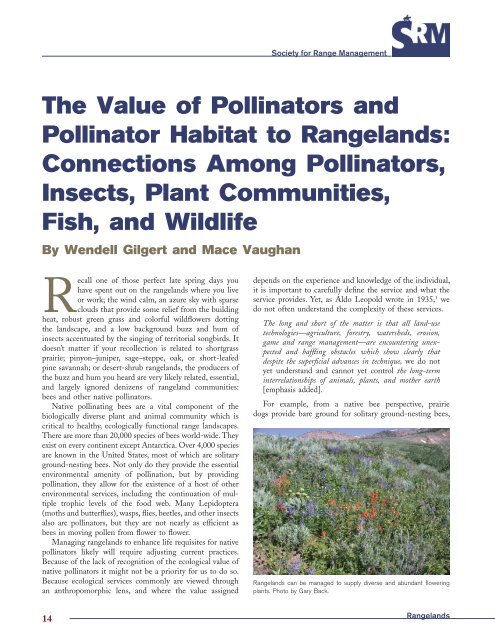Rangeland Magazine: Special Issue on Pollinators - The Xerces ...
Rangeland Magazine: Special Issue on Pollinators - The Xerces ...
Rangeland Magazine: Special Issue on Pollinators - The Xerces ...
You also want an ePaper? Increase the reach of your titles
YUMPU automatically turns print PDFs into web optimized ePapers that Google loves.
Society for Range Management<br />
<strong>The</strong> Value of <strong>Pollinators</strong> and<br />
Pollinator Habitat to <str<strong>on</strong>g>Rangeland</str<strong>on</strong>g>s:<br />
C<strong>on</strong>necti<strong>on</strong>s Am<strong>on</strong>g <strong>Pollinators</strong>,<br />
Insects, Plant Communities,<br />
Fish, and Wildlife<br />
By Wendell Gilgert and Mace Vaughan<br />
Recall <strong>on</strong>e of those perfect late spring days you<br />
have spent out <strong>on</strong> the rangelands where you live<br />
or work; the wind calm, an azure sky with sparse<br />
clouds that provide some relief from the building<br />
heat, robust green grass and colorful wildflowers dotting<br />
the landscape, and a low background buzz and hum of<br />
insects accentuated by the singing of territorial s<strong>on</strong>gbirds. It<br />
doesn’t matter if your recollecti<strong>on</strong> is related to shortgrass<br />
prairie; piny<strong>on</strong>–juniper, sage–steppe, oak, or short-leafed<br />
pine savannah; or desert-shrub rangelands, the producers of<br />
the buzz and hum you heard are very likely related, essential,<br />
and largely ignored denizens of rangeland communities:<br />
bees and other native pollinators.<br />
Native pollinating bees are a vital comp<strong>on</strong>ent of the<br />
biologically diverse plant and animal community which is<br />
critical to healthy, ecologically functi<strong>on</strong>al range landscapes.<br />
<strong>The</strong>re are more than 20,000 species of bees world-wide. <strong>The</strong>y<br />
exist <strong>on</strong> every c<strong>on</strong>tinent except Antarctica. Over 4,000 species<br />
are known in the United States, most of which are solitary<br />
ground-nesting bees. Not <strong>on</strong>ly do they provide the essential<br />
envir<strong>on</strong>mental amenity of pollinati<strong>on</strong>, but by providing<br />
pollinati<strong>on</strong>, they allow for the existence of a host of other<br />
envir<strong>on</strong>mental services, including the c<strong>on</strong>tinuati<strong>on</strong> of multiple<br />
trophic levels of the food web. Many Lepidoptera<br />
(moths and butterflies), wasps, flies, beetles, and other insects<br />
also are pollinators, but they are not nearly as efficient as<br />
bees in moving pollen from flower to flower.<br />
Managing rangelands to enhance life requisites for native<br />
pollinators likely will require adjusting current practices.<br />
Because of the lack of recogniti<strong>on</strong> of the ecological value of<br />
native pollinators it might not be a priority for us to do so.<br />
Because ecological services comm<strong>on</strong>ly are viewed through<br />
an anthropomorphic lens, and where the value assigned<br />
depends <strong>on</strong> the experience and knowledge of the individual,<br />
it is important to carefully define the service and what the<br />
service provides. Yet, as Aldo Leopold wrote in 1935, 1 we<br />
do not often understand the complexity of these services.<br />
<strong>The</strong> l<strong>on</strong>g and short of the matter is that all land-use<br />
technologies—agriculture, forestry, watersheds, erosi<strong>on</strong>,<br />
game and range management—are encountering unexpected<br />
and baffling obstacles which show clearly that<br />
despite the superficial advances in technique, we do not<br />
yet understand and cannot yet c<strong>on</strong>trol the l<strong>on</strong>g-term<br />
interrelati<strong>on</strong>ships of animals, plants, and mother earth<br />
[emphasis added].<br />
For example, from a native bee perspective, prairie<br />
dogs provide bare ground for solitary ground-nesting bees,<br />
<str<strong>on</strong>g>Rangeland</str<strong>on</strong>g>s can be managed to supply diverse and abundant flowering<br />
plants. Photo by Gary Back.<br />
14<br />
<str<strong>on</strong>g>Rangeland</str<strong>on</strong>g>s
















